A Photographer's Safari India
Duration of Tour : 24 Nights / 25 Days Programme
Sketch Itinerary : Delhi - Jaipur - Ranthambore - Bharatpu - Agra - Jhansi Khajuraho - Bandhavgarh - Kanha National Park - Nagpur - Kolkata - Guwahati - Kaziranga - Guwahati - Mumbai - Rajkot - Sasan Gir - Little Rann of Kutch - Ahemadabad - New Delhi.
Day 1: Arrival Delhi
Delhi the capital of India, is a historical city, which attracts the tourists because of its historical past. This city is one of the oldest city with lots of monuments and temples that are a sight to watch. Any visitor’s visit to this city will go incomplete without a visit to these historical places
Day 2: In New Delhi
Morning: Visit the Old City of Delhi to see the historic Red Fort and the Jama Masjid, India’s largest mosque from the outside. See the colourful bazaar of Chandni Chowk and take a cycle rickshaw ride through the back streets of Old Delhi to get a first hand experience of the hustle and bustle of this traditional city.
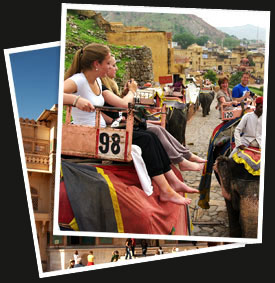
Elephant Ride, Jaipur
Afternoon: Visit New Delhi, seeing the Qutab Minar, a tower of victory built in the 12th century and India Gate - the war memorial. Drive past the Rashtrapathi Bhawan, the residence of the President of India, the houses of Parliament and the Government Secretariat buildings. Overnight in Delhi.
Day 3: New Delhi ![]() Jaipur
Jaipur
After breakfast drive to Jaipur, 260kms, 5 hours drive, on arrival check into hotel. Jaipur - the capital of Rajasthan, is colour washed pink - the colour associated with hospitality in Rajput culture. This Pink City of fairy tale palaces, rugged fortresses perched on barren hills and broad avenues, is picturesque. Overnight in Jaipur..
Day 4: In Jaipur
BOOK NOW
Morning proceed on an excursion to Amber Fort with an Elephant ride upto the top of the Fort. Drive past Hawa Mahal, known popularly as the Palace of Winds, is a facade built for the Ladies of the Royal household in the 19thcentury. The Amber Fort, the capital of the erstwhile State of Jaipur until 1728 is perched on a hill. It has halls of Public and Private audience, a Sheesh Mahal (hall of mirrors) various marble palaces which are marvelous examples of ancient Rajput architecture. The Temple of Amba (Mother Goddess), the patron deity of the Royal family is at the entrance to the palace. Ride an elephant to ascend the hill on which the Fort is situated.
Return to the town in the afternoon enroute visiting the City Palace - the former royal residence built in a blend of Rajasthani and Mughal styles which houses a museum with a superb collection of Rajasthani costumes and armoury of the Mughals and Rajputs, including swords of different shapes and sizes with ornate handles. It has an art gallery with an excellent collection of miniature paintings, carpets, royal paraphernalia and rare astronomical works in Arabic, Persian, Latin and Sanskrit. Also visit the Jantar Mantar - an astrological and astronomical observatory built by Maharaja Jai Singh in the 18th century, which is remarkable for its accuracy even in the present times. Overnight in Jaipur
Day 5: Jaipur ![]() Ranthambore
Ranthambore
Morning after breakfast drive to Ranthambore National Park. Lunch and afternoon game drive to The National Park. Dinner and overnight at Resort Ranthambore: With an area of 400 sq. km encompassing rocky hill crests which descend to open valleys between the Aravalli and Vindhya ranges, dotted with water pools and fruit trees, this park gets its name from the thousand year old fortress, which looms above the forest. Well known for the diurnal activity of tigers, Ranthambore is a very special and unusual area where a natural present meets a historical past. Sambar, cheetal, chinkara, nilgai and languor. The elusive leopard and tigers are found in this reserve with tourists standing a very good chance of seeing tigers during the day.
Dotted across the landscape are the crumbling ruins of its past glory, be it chatris or cupolas, like palaces or old guard posts, all of which reinforce the magical and ethereal quality of this great wilderness. Lunch at the lodge and afternoon game drive to the national park with an English-speaking Naturalist.
Day 6: In Ranthambore
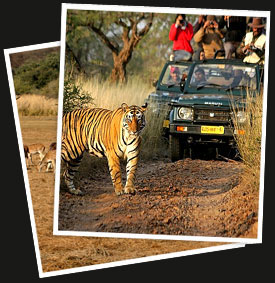
Jeep Safari, Ranthambore
Morning & Evening drives in the park. Breakfast, lunch and dinner at resort. Overnight in Ranthambore.During the day visit the famous Ranthambore Fort. (12 kms. from the Resort) Perhaps the only one fort, which is not visible from a long distance. The Fort is a massive enclave and quite high. Mughal Emperor Shah Alam gifted it to Sawai Madho Singh I of Jaipur in 1754 AD and since then it was maintained as the private hunting preserve. Much later, Queen Elizabeth II and Duke of Edinburgh were part of the Royal Hunting, who stayed here too. It’s a unique Rajput Fort.
Archeological Department took it in 1964. It is 1578 ft from the sea level and 750ft from ground. Total area of the fort is about 7 miles. There is no drive way up to the fort, just the stairs. There are three big artificial lakes up in the Fort. Overnight Tiger Den Resort.
Day 7: Ranthambore
Morning Game drive to the National Park later drive to Bharatpur 210 kms /5 hrs drive. On arrival Check into Hotel. Evening visit to the sanctuary.
BOOK NOW
Bharatpur is popular for its bird sanctuary - the Keoladeo Ghana National Park - finest in Asia, in which over 400 species of water birds. The sanctuary covers an area of 40 sq. km of swampy, lightly wooded terrain that was once the private hunting and shooting preserve of the Maharaja of Bharatpur. Today it is the protected breeding ground for many species of birds and also the home of migratory birds, especially of the Siberian Crane, that spends its winter here. Colonies of cormorants, spoonbills, storks, egrets, herons, pelicans, ibis and grey herons can be spotted all over the park, besides a fairly rich habitation of deer and snakes. [The best time to visit the park is from October though March] The park can be explored either by cycle rickshaws (the drivers are all very capable naturalists) or by boats on the lake. Overnight in Bharatpur.
Day 8: Bharatpur

Taj Mahal, Agra
Morning : Visit the Bharatpur Keoladeo Ghana Bird Sanctuary by cycle rickshaws (the rickshaw drivers are all very capable naturalists and drive from the wilderness of the forests to the places of historic significance that marks our beginning to the next place of our trip. Agra and Fateh pur Sikri.
Fatehpur Sikri - This exquisite city built by Akbar the Great in 1569, in red sandstone, with its forts, palaces and mosques was abandoned 14 years after its creation due to political reasons. The Diwan-i-am - a vast courtyard in which the emperor gave daily public audience; Diwan-i-khas - a large quadrangle which contained all the major functions of the Palace, Pachisi court, the Emperors private living quarter, Jodha Bhai’s Palace, Mariam’s Palace, Birbal’s Palace, Hawa Mahal and Panch Mahal are some of the important buildings of this residential complex. The Friday Mosque and the exquisite tomb of Sheik Salim Chisti are in the religious grounds set aside in a separate enclosure adjacent to the secular buildings.
Continue drive to Agra after visiting Fatehpur Sikri (49 kms). On arrival, check in to the hotel.
Agra is famous as the home to one of the Seven Wonders of the World - the Taj Mahal. The architectural splendor of the mausoleums, the fort and the palaces in Agra is a vivid reminder of the opulence of the legendary Mughal Empire. Agra was their capital for nearly a hundred years from 1564. A pleasant town, with a comparatively easy pace, Agra is known for its superb inlay work on marble and soapstone by artisans who are hereditary crafts persons. The city is also famous for its carpets, gold thread embroidery and leather shoes.
Visit the Agra Fort, built by three Mughal Emperors starting from Akbar the Great in 1565 AD, which is a masterpiece of design and construction. Within the fort are a number of exquisite buildings including the Moti Masjid, Jahangir’s Palace, Khas Mahal and the Sheesh Mahal, Diwane-i-Am, Diwane-i-Khas and Musamman Burj, where Emperor Shah Jahan, the fifth Mughal Emperor, died a prisoner. Later visit the Taj Mahal - the inimitable poem in white marble. Built over a period of 22 years, by the Mughal Emperor Shah Jahan in 1630, for his Queen Mumtaz Mahal to enshrine her mortal remains, it is one of the seven modern wonders of the World. [ The Taj is closed on Friday. Overnight in Agra.
Day 9: Agra![]() Jhansi
Jhansi![]() Khajuraho
Khajuraho
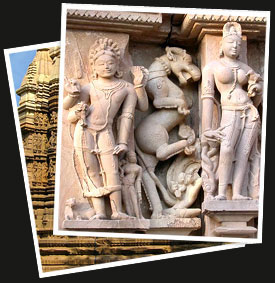
Vamana Temple, Khajuraho
Morning sunrise visits to Taj Mahal and after breakfast transfer to Railway station to board a Executive Chair car train to Jhansi at 0815 hrs. Arrive Jhansi at 1115 hrs and drive to Khajuraho 180kms/ 4 hrs drive.
Khajuraho discovered by chance, India's second biggest single tourist attraction, Khajuraho has the largest group of medieval temples that are adorned with numerous sculptures of extraordinary grace and delicacy celebrating the stylized and refined courtly accomplishments of beauty, love and creative arts. Once the religious capital of the Chandela Rajputs, the temples of the city date from 950-1050 AD. A wall with eight gates encloses the entire area and two golden palm trees flank each of them. Originally, there were over 80 temples, of which only 22 now can be said remarkably preserved. The set of temples at Khajuraho celebrating Hindu religious thought in its mystifying variety of scope and inclusion stands distinguished from rest of the Hindu temples. The temples highlight the existential ethos in religion that venerates 'Yoga' and 'Bhoga'. 'Yoga' is union of the self with the Almighty, while 'Bhoga' is the path to God through physical pleasure. The temples at Khajuraho, dedicated to physical love and pleasure are a testimony to this philosophy. Declared a World Heritage Site in 1986, Khajuraho is a prominent, must-see destination and its temples are India's unique gift to the world as they capture life in every form and mood in stone. Evening Sound and light show at Khajuraho. Overnight at Khajuraho. Overnight at Khajuraho.
Day 10: Khajuraho
Morning after breakfast drive to Bandhavgarh National Park 280 kms /6 hrs. On arrival check into Tiger’s Den Resort. Lunch at Resort and afternoon game drive to National Park. Dinner and overnight at Tiger’s Den Resort
Day 11: In Bandhavgarh
Morning and afternoon game drives, meals and overnight Jungle Lodge
Bandhavgarh
The national park is mainly known for its tiger population. This is the place where famous White Tigers of Rewa were discovered. The other wild attractions in the park include Nilgai, Chausingha, Chital, Chinkara, Wild Boar, a Fox and a Jackal. There are at least 22 mammal species and about 250 bird species in the Park. The grasslands in the park consist of chinkara (Indian gazelle), nilgai (blue bull) and chausingha (four-horned antelope) and wild boar. The dense forests contain sambhar (Indian stag), the muntjac (barking deer) and the herds of chital (spotted deer).
The other animals found in Bandhavgarh are ratel, porcupine, small Indian civet, palm squirrel, lesser bandicoot rat, the jungle cat, hyena and jackal, sloth bear, and the elusive Leopard. The reptile population in the park includes cobras, karaits, vipers, ratsnakes, pythons, lizards and turtles. The two primate species - the rhesus macaque and the Hanuman langur - inhabit the Bandhavgarh Park.
Bandhavgarh is justifiably famous for its Tigers, but it has a wide range of other game. The undergrowth is not as dense as in some northern terai forests, but the best time to see the park inhabitants is still the summer months when water becomes more scarce and the undergrowth dies back
Day 12: Bandhavgarh
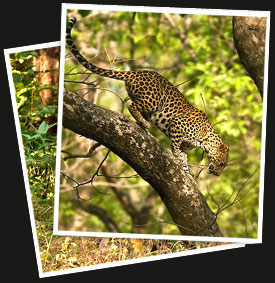
Leopard, Kanha National Park
Morning game drive, after breakfast depart for Kanha, 250kms, 6 hours drive, carry packed Lunch, evening relax.
Kanha's sal and bamboo forests, rolling grasslands and meandering streams stretch over 940 sq km in dramatic natural splendour which form the core of the Kanha Tiger Reserve created in 1974 under Project Tiger. The park is the only habitat of the rare hardground Barasingha (Cervus Duvaceli Branderi).
This is original Kipling country of which he wrote so vividly in his Jungle Book. The same abundance of wild life species exists today in Kanha National Park, as it must have when Kipling roamed these parts.
Dinner and overnight at Chitvan Jungle Lodge
Day 13: In Kanha
Breakfast and lunch at Chitvan Jungle Lodge. Morning and afternoon Jeep safari to the National park.
The Kanha National Park, stretching over 940 sq km, the vegetation, chiefly made of sal and bamboo forests, grasslands and streams, this park is the sole habitat of the rare hardground barasingha.
The forests of the Banjar valley and Halon valley, respectively forming Kanha's western and eastern halves, had even , at the turn of the century, been famous for their deer and tiger population. By a special statute in 1955, Kanha National Park came into being. Since then, a string of stringent conservation programmes have been launched, for the overall protection of the park's fauna and flora. It is one of the most well-maintained National Parks in Asia, and a major attraction for avid wildlife buffs all over the world.
Kanha boasts of about 22 species of mammals. Some of the inhabitants of this park are the gaur, the largest of the world's cattle; the sambar, the largest Indian deer; and the chausingha, the only four-horned antelope in the world. Other frequent visitors include the Nilgai antelope, the sloth bear, the dhole, or Indian wild dog, and an occasional panther. Some 200 species of birds inhabit the park, that include the cattle egret, black ibis, hawk eagle, and the red-wattled lapwing. Shravantal is an old, earthenbound tank in the central Kanha meadows, which happens to be an important watering hole, for a large number of water fowl in winter. Bamni Dadar, known as Sunset Point, is the most beautiful section of the park, and the view of the sunset from this spot is absolutely mesmerising. Quite a few animals can be sighted around this area which include the sambar, gaur, the four-horned antelope and the barking deer.
Evening bar be que dinner followed by Tribal Dance. Overnight at Chitvan Jungle Lodge.
Day 14: Kanha
Morning game drive to the national Park. After Lunch drive to <> 250 kms /5 hrs drive to board a flight to Kolkata at 1910 hrs. Arrive < > 2100 hrs and transfer to Hotel. Overnight at Kolkata.
Day 15: Kolkata ![]() Guwahati
Guwahati ![]() Kaziranga
Kaziranga
Morning after breakfast transfer to airport to board a flight to Guwahati at 1010hrs. Meeting and assistance on arrival at Guwahati airport at 1120 hrs and drive to Kaziranga National Park 250 kms/5hrs drive. Dinner and overnight at Wild Grass Resort.
Day 16: In Kaziranga
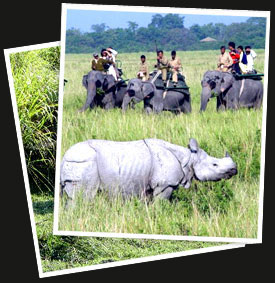
Rhino, Kaziranga National Park
Morning and afternoon game drives, meals and overnight at Resort.
Kaziranga National Park lies partly in Golaghat District and partly in Nagaon District of Assam. It is the oldest park in Assam covers an area of 430 Sq. kms along the river Brahmaputra on the North and the Karbi Anglong hills on the South. The National Highway 37 passes through the park area and tea estates, hemmed by table-top tea bushes. One can even see the rhinos and wild elephants straying near the highway.
Kaziranga National Park a world heritage site is famous for the Great Indian one horned rhinoceros, the landscape of Kaziranga is of sheer forest, tall elephant grass, rugged reeds, marshes & shallow pools. It has been declared as National Park in 1974.
Kaziranga National Park is one of the last areas in eastern India undisturbed by a human presence. It is inhabited by the world's largest population of one-horned rhinoceroses, as well as many mammals, including tigers, elephants, panthers and bears, and thousands of birds. The park is open from November to April. Tourists can take rides on elephants to move around the park or cruise in a boat on the Brahmaputra along the park.
Day 17: In Kaziranga
Morning and afternoon game drives, meals and overnight at Resort. Kaziranga National Park offers different safari option for wildlife enthusiast to see the wild animals in their natural habitat ( Kaziranga National Park). The best time to visit the park for safari is Nov to May. Safari can be under taken at kaziranga by Jeeps and Elephants Only. During safari into the national park you can easily spot animals like the tiger, rhino, water buffaloes, wild bora, gaur, leopard cats, blackbucks, otters, monitor lizard, barasingha and of course wild elephants. Kaziranga has a large population of colorful birds. Some of the birds that can be commonly sighted during your Kaziranga wildlife safari are the flamingoes, cranes, grey-headed fishing eagle, whistling teal, crested serpent eagle, open-billed stork, swamp partridge, osprey, cormorant, herons, marsh harrier and other birds.
Day 18: Kaziranga ![]() Guwahati
Guwahati ![]() Mumbai
Mumbai
Morning game drive to the park and after breakfast drive to Guwahati 250kms to board a flight at 1425 hrs to arrive Mumbai at 1740 hrs . Meeting and assistance on arrival at Mumbai and transfer to the hotel. Overnight at Mumbai.
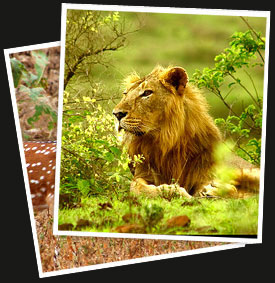
Lion, Sasan Gir National Park
Day 19: Mumbai ![]() Rajkot
Rajkot ![]() Sasan Gir
Sasan Gir
Early morning board flight to <> at 0735hrs. Arrive <> at 0855hrs and drive to Sasan Gir 165 kms / 4hrs drive. On arrival check into Resort. Lunch, & afternoon game drive. Dinner and overnight at Resort
Day 20: In Sasan Gir
Morning and afternoon game drive to the National Park. Meals and overnight at Lion Safari Camp. Gir is the only home in India for the Asiatic Lion of which there are nearly 300 in the park. The Gir National Park lies in the Gujarat peninsula in South-Western India. The terrain is rugged with low hills and the vegetation is mixed deciduous, with stands of Teak, Acacia, Jamun, Tendu and Dhak trees, interspersed with large patches of grasslands. The trees on the hills are sparse and stunted. Within the sanctuary, there are numerous human settlements of cattle herders called Maldharis with an estimated 20,000 head of livestock (which, incidentally, forms a significant part of the Lion’s diet). There are also places of Hindu worship and pilgrimage and sulphur springs at Tulsi Shyam and Kankai Mata. The edges of the park have good population of Indian Gazelle, protected by religious sentiments of the local people.
BOOK NOWDay 21: In Sasan Gir
Morning and afternoon game drive to the National Park. Meals and overnight at Lion Safari Camp.
Day 22: Sasan Gir ![]() Little Rann of Kutch
Little Rann of Kutch

cranes, Little Rann of Kutch
The Little Rann of kutch is a birdwatcher's paradise in winter. Houbara bustard, sandgrouse, desert chat, desert wheatear, nine species of larks, quails, gray francolin etc are seen in the saline desert wilderness. Eagles, vultures, harriers and falcons can be seen hunting in the Rann. The marshes in the Rann, and nearby lakes like Nawa Talao and Vanod Saran, attract huge flocks of water birds. Flamingoes, pelicans, cranes, storks, ducks etc can be seen in large numbers.
Day 23: Little Rann of Kutch
Full day safari at Little Rann of Kutch. Overnight at Rann Riders The Wild Ass Sanctuary is located in the Little Rann of Kutch of the Gujarat State in India. It covers an area of 4954 km². The Sanctuary is named after a sub species of wild ass (Equus hemionus khur), the last population of which it harbours. The Rann is one of the most remarkable and unique landscapes of its kind in the entire world. It is a vast desiccated, unbroken bare surface of dark silt, encrusted with salts which transforms into a spectacular coastal wetland after the rains. The present saline desert of the Little Rann (saline desert-cum-seasonal wetland) of Kutch is believed to have been shallow sea. The variety of the geomorphic facets of Kutch such as the present surface configuration, its landforms, drainage characteristics and relief pattern clearly reveals a complex interplay of tectonics, sea-level changes and lithology as also erosion and deposition.
Day 24: Little Rann of Kutch ![]() Ahemadabad - New Delhi
Ahemadabad - New Delhi
Morning game drive at Little Rann of Kutch and later drive to Ahemadbad to board a flight to New Delhi at 1950hrs to Arrive New Delhi at 2110hrs. Meetings and assistance on arrival at New Delhi and transfer to Hotel. Overnight at New Delhi
BOOK NOWDay 25: Back to home
Morning free for leisure activity and later transfer to international airport to board a flight back home.


